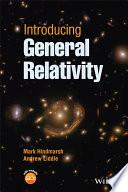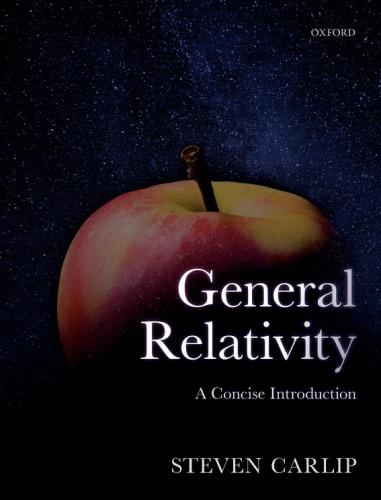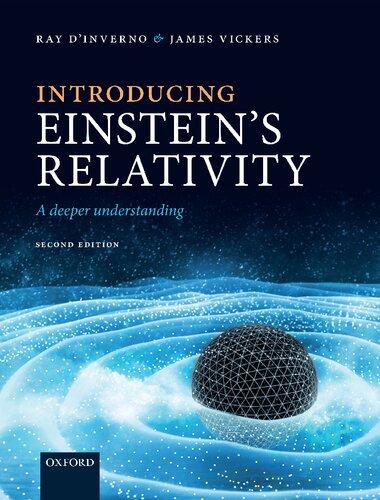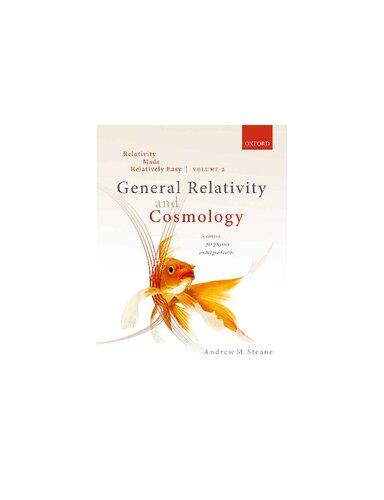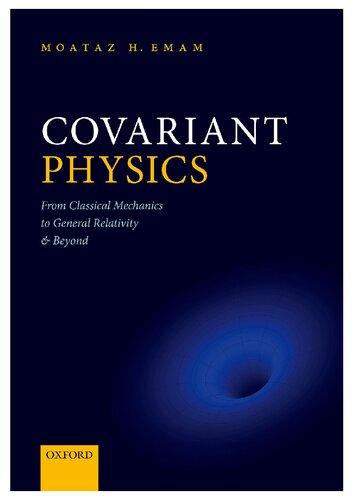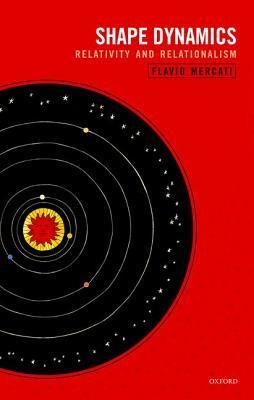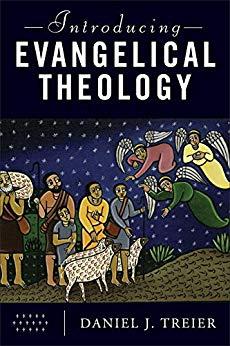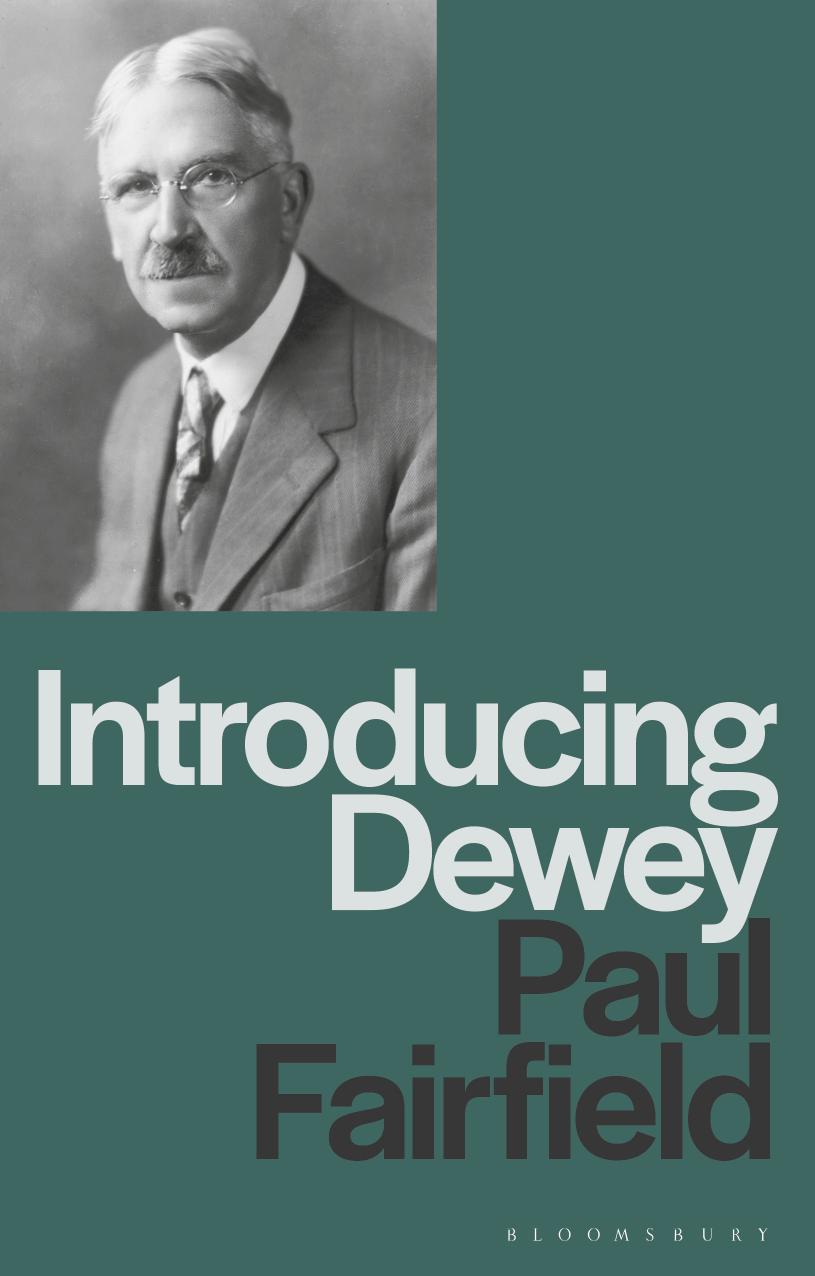Introducing General Relativity Mark Hindmarsh Visit to download the full and correct content document: https://ebookmass.com/product/introducing-general-relativity-mark-hindmarsh/
More products digital (pdf, epub, mobi) instant download maybe you interests ...
General relativity : a concise introduction Carlip
https://ebookmass.com/product/general-relativity-a-conciseintroduction-carlip/
Introducing Einstein's Relativity: A Deeper Understanding 2nd Edition Ray D'Inverno
https://ebookmass.com/product/introducing-einsteins-relativity-adeeper-understanding-2nd-edition-ray-dinverno/
Special relativity, electrodynamics, and general relativity : from Newton to Einstein Second Edition Kogut
https://ebookmass.com/product/special-relativity-electrodynamicsand-general-relativity-from-newton-to-einstein-second-editionkogut/
Relativity Made Relatively Easy. Volume 2: General Relativity and Cosmology Andrew M. Steane
https://ebookmass.com/product/relativity-made-relatively-easyvolume-2-general-relativity-and-cosmology-andrew-m-steane/
Covariant Physics - From Classical Mechanics to General Relativity and Beyond 1st Edition Moataz H. Emam
https://ebookmass.com/product/covariant-physics-from-classicalmechanics-to-general-relativity-and-beyond-1st-edition-moataz-hemam/
Shape Dynamics: Relativity and Relationalism Flavio Mercati
https://ebookmass.com/product/shape-dynamics-relativity-andrelationalism-flavio-mercati/
Introducing Evangelical Theology
https://ebookmass.com/product/introducing-evangelical-theology/
Introducing Dewey Fairfield
https://ebookmass.com/product/introducing-dewey-fairfield/
Relativity without spacetime Cosgrove
https://ebookmass.com/product/relativity-without-spacetimecosgrove/
IntroducingGeneralRelativity IntroducingGeneralRelativity University of Sussex Brighton, UK and
University of Helsinki Helsinki, Finland
AndrewLiddle University of Edinburgh Edinburgh, UK and
Perimeter Institute for Theoretical Physics Waterloo, Canada and
Universidade de Lisboa Lisboa, Portugal
MarkHindmarsh
This edition first published 2022
© 2022 John Wiley and Sons Ltd
All rights reserved. No part of this publication may be reproduced, stored in a retrieval system, or transmitted, in any form or by any means, electronic, mechanical, photocopying, recording or otherwise, except as permitted by law. Advice on how to obtain permission to reuse material from this title is available at http://www.wiley.com/go/permissions.
The right of Mark Hindmarsh and Andrew Liddle to be identified as the authors of this work has been asserted in accordance with law.
Registered Offices
John Wiley & Sons, Inc., 111 River Street, Hoboken, NJ 07030, USA
John Wiley & Sons Ltd, The Atrium, Southern Gate, Chichester, West Sussex, PO19 8SQ, UK
Editorial Office
The Atrium, Southern Gate, Chichester, West Sussex, PO19 8SQ, UK
For details of our global editorial offices, customer services, and more information about Wiley products visit us at www.wiley.com.
Wiley also publishes its books in a variety of electronic formats and by print-on-demand. Some content that appears in standard print versions of this book may not be available in other formats.
Limit of Liability/Disclaimer of Warranty
In view of ongoing research, equipment modifications, changes in governmental regulations, and the constant flow of information relating to the use of experimental reagents, equipment, and devices, the reader is urged to review and evaluate the information provided in the package insert or instructions for each chemical, piece of equipment, reagent, or device for, among other things, any changes in the instructions or indication of usage and for added warnings and precautions. While the publisher and authors have used their best efforts in preparing this work, they make no representations or warranties with respect to the accuracy or completeness of the contents of this work and specifically disclaim all warranties, including without limitation any implied warranties of merchantability or fitness for a particular purpose. No warranty may be created or extended by sales representatives, written sales materials or promotional statements for this work. The fact that an organization, website, or product is referred to in this work as a citation and/or potential source of further information does not mean that the publisher and authors endorse the information or services the organization, website, or product may provide or recommendations it may make. This work is sold with the understanding that the publisher is not engaged in rendering professional services. The advice and strategies contained herein may not be suitable for your situation. You should consult with a specialist where appropriate. Further, readers should be aware that websites listed in this work may have changed or disappeared between when this work was written and when it is read. Neither the publisher nor authors shall be liable for any loss of profit or any other commercial damages, including but not limited to special, incidental, consequential, or other damages.
Library of Congress Cataloging-in-Publication Data
ISBN: 9781118600719
Cover Design: Wiley Cover Images: © ESA/Hubble & NASA, S. Jha; Acknowledgment: L. Shatz
Set in 10/12pt NimbusRomNo9L by Straive, Chennai, India applied for
3TensorsinSpecialRelativity17
4TowardsGeneralRelativity37
4.4.1Gravitationalredshift....................45
4.4.2Gravitationaltimedilation.................46
4.5PrinciplesoftheGeneralTheoryofRelativity...........47
4.6Towardscurvedspace–time.....................49
4.7Curvedspaceintwodimensions..................50
5TensorsandCurvedSpace–Time57
5.1Generalcoordinatetransformations.................57
5.2Tensorequationsandthelawsofphysics..............59
5.3Partialdifferentiationoftensors..................59
5.4Thecovariantderivativeandparalleltransport...........60
5.5Christoffelsymbolsofatwo-sphere................65
5.6Paralleltransportonatwo-sphere.................66
5.7CurvatureandtheRiemanntensor.................68
5.8Riemanncurvatureofthetwo-sphere................71
5.9Moretensorsdescribingcurvature.................72
5.10Localinertialframesandlocalflatness...............73
6DescribingMatter79
6.1TheCorrespondencePrinciple...................79
6.2Theenergy–momentumtensor...................80
6.2.1Generalproperties.....................80
6.2.2Conservationlawsand4-vectorflux............81
6.2.3Energyandmomentumbelonginarank-2tensor.....83
6.2.4Symmetryoftheenergy–momentumtensor........84
6.2.5Energy–momentumofperfectfluids............84
6.2.6Theenergy–momentumtensorincurvedspace–time...87
7TheEinsteinEquation91
7.1TheformoftheEinsteinequation.................91
7.2PropertiesoftheEinsteinequation.................93
7.3TheNewtonianlimit........................93
7.4Thecosmologicalconstant.....................95
7.5ThevacuumEinsteinequation...................96
8TheSchwarzschildSpace–time99
8.1Christoffelsymbols.........................100
8.2Riemanntensor...........................101
8.3Riccitensor.............................102
8.4TheSchwarzschildsolution.....................103
8.5TheJebsen–Birkhofftheorem....................104
9GeodesicsandOrbits109
9.1Geodesics..............................109
9.2Non-relativisticlimitofgeodesicmotion..............112
9.3Geodesicdeviation.........................113
9.4Newtoniantheoryoforbits.....................115
9.5OrbitsintheSchwarzschildspace–time..............117
9.5.1Massiveparticles......................117
9.5.2Photonorbits........................120
10TestsofGeneralRelativity123 10.1PrecessionofMercury’sperihelion.................123
10.2Gravitationallightbending.....................125
10.3Radarechodelays..........................127
10.4Gravitationalredshift........................129
10.5BinarypulsarPSR1913+16....................131
10.6Directdetectionofgravitationalwaves...............135
11BlackHoles139
11.1TheSchwarzschildradius......................139
11.2Singularities.............................140
11.3RadialraysintheSchwarzschildspace–time............141
11.4Schwarzschildcoordinatesystems.................143
11.5Theblackholespace–time.....................145
11.6Specialorbitsaroundblackholes..................147
11.7Blackholesinphysicsandinastrophysics.............148
12Cosmology155
12.1Constant-curvaturespaces.....................156
12.2ThemetricoftheUniverse.....................158
12.3ThemattercontentoftheUniverse.................158
12.4TheEinsteinequations.......................159
13CosmologicalModels165 13.1Simplesolutions:matterandradiation...............165
13.2Lighttravel,distances,andhorizons................169
13.2.1Lighttravelinthecosmologicalmetric..........169
13.2.2Cosmologicalredshift...................170
13.2.3Theexpansionrate.....................171
13.2.4TheageoftheUniverse..................172
13.2.5Thedistance–redshiftrelationandHubble’slaw......172
13.2.6Cosmichorizons......................173
13.2.7Theluminosityandangular-diameterdistances......174
13.3Ingredientsforarealisticcosmologicalmodel...........175
13.4Acceleratingcosmologies......................180
14GeneralRelativity:TheNext100Years183
14.1DevelopingGeneralRelativity...................183
14.2BeyondGeneralRelativity.....................184
14.3Intothefuture............................187
AdvancedTopicA1GeodesicsintheSchwarzschildSpace–Time191
A1.1Geodesicsandconservationlaws..................191
A1.2Schwarzschildgeodesicsformassiveparticles...........192
A1.3Schwarzschildgeodesicsformasslessparticles..........194
AdvancedTopicA2TheSolarSystemTestsinDetail197
A2.1Newtonianorbitsindetail......................197
A2.2PerihelionshiftinGeneralRelativity................201
A2.3Lightdeflection...........................204
A2.4Timedelay.............................205
AdvancedTopicA3WeakGravitationalFieldsandGravitationalWaves209
A3.1Nearly-flatspace–times.......................209
A3.2Gravitationalwaves.........................211
A3.3Sourcesofgravitationalwaves...................214
AdvancedTopicA4GravitationalWaveSourcesandDetection219
A4.1Gravitationalwavesfromcompactbinaries............220
A4.2Theenergyingravitationalwaves.................223
A4.3Binaryinspiral...........................224
A4.4Detectinggravitationalwaves....................227
A4.4.1Laserinterferometers....................227
A4.4.2Pulsartiming........................230
A4.4.3Interferometersinspace..................231
Preface Findaphysicist.Sitthemdown,treatthemtoacoffee,andaskfortheiropinion astothemostbeautifultheorythatthesubjecthastooffer.Thechancesarethat theiranswerwillbeGeneralRelativity.
Einstein’sGeneralTheoryofRelativity,togiveititsfullandpropername, isoverahundredyearsold.Yetitoffersadefiantlymodernviewpoint,definingprinciplesofhowtheUniverseoughttoworkandestablishingamathematicalframeworkuponthem.Itgivesaradical,evenshocking,reconceptionofa fundamentalforce,gravity.Andithasmaintainedanexquisiteagreementwith observationaldata,makingpredictionsofsuchsubtletythatoneofitskeyimplications,theexistenceofgravitationalwaves,tookoverahundredyearstobe directlyverified.
ThisbookisbasedonalecturecourseattheUniversityofSussex,givenby eachofusatvarioustimes.Thecourseistakenbyfinal-yearphysicsundergraduates,andhasnospecialprerequisites,sowehaveattemptedtolimitthecoverage oftopicsandtobeasexplicitaspossible.Formanyundergraduates,alecture courseonGeneralRelativityisthepinnacleoftheirtheoreticaleducation,and theirmainexposuretothemodernmethodologyofphysicsasbasedonprinciples andsymmetries.
Ouraimistomakethatexperienceasenjoyableaspossible,whileaccepting thatthepleasurecomesnotjustfromtheastonishingphysicalimplications,such asblackholes,singularities,andgravitationalwaves,butfromtheeleganceofthe underlyingmathematicalstructure.Bythestandardsoftextbooksonthetopic, wehavesoughttocreatesomethingthatisgenuinelyintroductory,yetwhichprovidesthemathematicaltoolstoseethetheoryworkinaquantitativeway.We hopethatsomethingoftheeleganceofthetheoryemergesfromthetechnicaldifficulty,alongwithanunderstandingofthephysicalpredictionsthathavebeen sobeautifullyconfirmedbydecadesofexperimentandobservation.Enjoythe challenge!
MarkHindmarshandAndrewLiddle HelsinkiandLisbon,October2021
SomeFundamentalConstantsandAstronomicalValues Newton’sgravitationalconstant G 6 672 × 10 11 m3 kg 1 s 2
Speedoflight c 2.998 × 108 ms 1
ReducedPlanckconstant¯h = h/2π 1 055 × 10 34 m2 kgs 1
Boltzmannconstant kB 1.381 × 10 23 JK 1
Solarmass M⊙ 1 M⊙ = 1 989 × 1030 kg
Solarradius R⊙ 1 R⊙ = 6 957 × 108 m
Parsecpc1pc = 3 086 × 1016 m
ElectronvolteV1eV = 1 602 × 10 19 J
Commonly-UsedSymbols t , x, y, z coordinates definedonpage 4
c speedoflight5
v velocity(usuallytherelativevelocitybetweentwoframes)6
γ Lorentzboostfactor, γ = 1/ 1 v2 /c2 7
s or ∆s space–timedistance(orinterval)betweentwoevents7,19
u velocity(ofanobjectmeasuredinaframe)11
x µ coordinates(asa4-vector)18
Λ µ ν Lorentztransformation18
η µν Minkowskimetric(forSpecialRelativity)19
g µν metricofspace–time20,50
δ µ ρ Kroneckerdelta21
τ propertime24
u µ 4-velocity24
p µ 4-momentum25,83
a µ 4-acceleration(thisnotationisalsousedforageneric4-vector)26
4-derivative27
✷ D’Alembertian27
G Newton’sgravitationalconstant37
M mass(usuallyofagravitatingbody)37
m mass(usuallyofatestbodynearalargermass M )37
Φ gravitationalpotential39
ds infinitesimalintervalinspace–time50
Da µ covariantdifferential60
Γν µσ connection/Christoffelsymbols60 , partialderivative63 ;covariantderivative63
R µ ναβ Riemanntensor69
R µν Riccitensor72
R Ricciscalar72
ρ density80
n (particle)numberdensity81
j µ (particle)flux4-vector82
T µν energy–momentumtensor83
p pressure85
G µν Einsteintensor92 Λ cosmologicalconstant95
rS Schwarzschildradius104
t µ tangentvector(toatrajectory)110
a(t ) scalefactoroftheUniverse158
h µν smallperturbationtothemetric g µν 209
About the Companion Website This book is accompanied by a companion website: www.wiley.com/go/hindmarsh/introducingGR
The website includes: Instructor’s Manual
Chapter1 IntroducingGeneralRelativity ItisnowmorethanahundredyearssinceAlbertEinsteinpresentedthefinal formoftheGeneralTheoryofRelativitytothePrussianAcademyofSciences,in November1915.Sincethen,ithasmigratedfromanextraordinaryachievement atthefrontiersofphysics,reputedlyunderstoodbyonlyaveryfew,toastandard advancedundergraduatecourse.GeneralRelativity(asitisusuallycalled,commonlyshortenedtosimplyGR)isessentialfortheunderstandingoftheUniverse asawhole,wherevergravityisstrong,andalsowheneverprecisetimemeasurementsaremade.TheGlobalPositioningSystem(GPS),nowbuiltintobillionsof devicesaroundtheworld,wouldnotworkwithouttheGeneralRelativisticpredictionthatclocksrunmoreslowlyonEarththaninthesatellitesdefiningtheGPS referenceframe.
PartofthefascinationofGeneralRelativityliesinthepersonalityofEinstein, andthewayheisoftenpresentedasalonegeniusworkingforyearsinisolation, finallytoreemergewiththefullyformedandbeautifultheoryweknowtoday. Inreality,hewasinconstantcommunicationwithotherscientists,andothers wereworkingtowardsarelativistictheoryofgravitation.Thefirstsuchtheory wasactuallywrittendownbyGunnarNordströmin1913,whoattemptedadirect relativisticgeneralisationoftheNewtoniangravitationalpotential.Einsteinwas thefirsttounderstandthattheappropriatedynamicalquantityisthespace–time metricitself,butthegeometricaspectofGeneralRelativitywasprobablyfirst appreciatedbythemathematiciansMarcelGrossmannandDavidHilbert.EinsteinworkedwithhisfriendGrossmann,andhadcrucialcorrespondencewith Hilbertbeforecomingupwiththefinalandcorrectformulation.Einsteinhimself tookseveralwrongturningsdoingtheyearsbetween1907and1915whenhewas workingmostintensivelyonthetheory.Thelonegeniusisamyth,butitisfairto considerthatGeneralRelativityisEinstein’sown,andcrowning,achievement. ThetechnicalcomplexityofGeneralRelativitycomesfromseveralsources.
Introducing General Relativity, First Edition. Mark Hindmarsh and Andrew Liddle.
Thefundamentalobjectsofrelativityaretensors,becausetherelativityprinciples (bothspecialandgeneral)arestatementsaboutthepropertiesofphysicallaws undertransformationsbetweencoordinates.ThusanyGeneralRelativitycourse muststartwithtensorcalculus.GeneralRelativityisageometricaltheory,treatingspace–timeasamanifold,describingitsdynamicsintermsofgeometrical quantities.ThusinapproachingGeneralRelativitythebasicgeometricalconcepts developedbyBernhardRiemannandothersfromthemid1800s—ofconnection, geodesic,paralleltransport,andcurvature—mustbeintroduced.Tensorcalculus andRiemanniangeometryarenotpartofthestandardmathematicalequipmentof aphysicsundergraduate.ThiswasalsotrueinEinstein’sundergraduatecareer, althoughtherewerecoursesonoffer.Ithasbeenspeculatedthathadhegoneto anadvancedgeometrycourse,hewouldhavelatersavedhimselfseveralyears’ work.
Afinaldifficultyistheoneoftranslatingthemathematicalconceptsintophysicalobservables.GeneralRelativityrethinksthefundamentalsofspaceandtime, whichtakepartinphysicalprocessesratherthanbeingaframeworkonwhich thingshappen.Sodecidingwhatisobservable,ratherthansimplyanartefactof aparticularchoiceofcoordinates,isdifficult.Indeed,Einsteinchangedhismind acoupleoftimesastowhethergravitationalwaveswererealornot,andittook aboutfiftyyearsforaunanimousviewtoemerge.
Gravitationalwaves,anearlypredictionofGeneralRelativity,areamongst thehottesttopicsinphysicsfollowingtheirdirectdetectionbytheLIGO/Virgo collaboration,announcedin2016.Theirrealsignificanceisnotsomuchasa triumphantvindicationofEinstein’stheory;therewasnoseriousdoubtthatgravitationalwavesexistedfollowingthecarefulmeasurementsoftheorbitaldecay ofabinarypulsarsystemdiscoveredbyRussellHulseandJosephTaylorinthe 1970s.Rather,thedetectionsignalsthebeginningofanewbranchofastronomy, whichhastheprospectofdetectingviolentastronomicaleventsrightbacktothe veryearlieststagesoftheBigBang.Newdetectors,similartoLIGOandVirgo, arebeingbuiltinJapanandIndia,andaspace-basedgravitationalwavedetector calledLISAisplannedfortheearly2030s.GeneralRelativitywillcontinuetobe attheforefrontofscientificresearchinthe21stcentury,asitwasthroughoutthe 20th.
Chapter2 ASpecialRelativityReminder TheSpecialTheoryunitesspaceandtime shorterlengthsand longertimes · seeingitwithdiagrams
BeforelaunchingintoouraccountofGeneralRelativity,wegiveabriefreminderofthemaincharacteristicsofitspredecessortheory,theSpecialTheory ofRelativity.ThiswasintroducedbyEinsteinin1905,andisusuallyreferredto bytheshorthandSpecialRelativity.Thesetheorieshavearatherdifferentstatus totraditionalphysicstopics,suchaselectromagnetismoratomicphysics,which seektounderstandphenomenaofaparticulartypeorwithinacertaindomain.Instead,therelativitytheoriessetdownprincipleswhichapplyto all physicallaws andrestrictthewaysinwhichtheycanbeputtogether.Whetherthoseprinciplesareactuallytrueissomethingthatneedstobetestedagainstexperimentand observation,buttheassumptionthattheydoholdhasfar-reachingimplications forhowphysicallawscanbeconstructed.Inparticular,theroleofsymmetries ofNatureishighlighted,whichisadefiningfeatureofhowmodernphysicsis constructed;assuchtherelativitytheoriesoftengivestudentsthefirstglimpseof howcontemporarytheoreticalphysicsisdone.
Boththetheoriesfocusonhowphysicalphenomenaareviewedindifferent coordinatesystems,withtheunderlyingprinciplethattheoutcomeofphysical processesshouldnotdependonthechoiceofcoordinatesthatweusetodescribe them.SpecialRelativityrestrictsustoso-called inertialframes,wheretheterm frame meansasetofcoordinatestobeusedfordescribingphysicallaws.As wewillsee,thisrestrictsustocoordinatetransformationswhicharelinearinthe coordinates,correspondingtocoordinatesystemsmovingrelativetooneanother withconstantvelocity,and/orrotatedwithrespecttooneanother.Thisturnsoutto beasuitableframeworkforconsideringallknownphysicallaws exceptforthose correspondingtogravity.
Einstein’sremarkableinsight,leadingtotheGeneralTheoryofRelativity,was Introducing General Relativity, First Edition. Mark Hindmarsh and Andrew Liddle.
thatallowingarbitrarynon-linearcoordinatetransformationswouldallowgravity tobeincorporated.Indeed,ifwewanttoallownon-lineartransformations,we have toincludegravity.Understandingthemotivationsfor,andimplicationsof, thisextraordinarystatementisthepurposeofthisbook.Butfornow,weplacethe focusonSpecialRelativity,emphasisingthosefeaturesthatwilllatergeneralise.
2.1TheneedforSpecialRelativity InNewtoniandynamics,theequationsareinvariantundertheGalileantransformationwhichtakesusfromonesetofcoordinates (t , x, y, z) toanother (
) accordingtotherule
where v istherelativespeedbetweenthetwocoordinatesystems,whichhave beenalignedsothatthevelocityisentirelyalongthe x direction.[NBprimes arenotderivatives!]Eachcoordinateframeisidealisedasextendingthroughout spaceandtime,providingthescaffoldingthatletsuslocatephysicalprocessesin spaceandtime.Weintroducean event assomethingwhichhappensataspecific locationinspaceandataspecifictime,suchasthecollisionoftwoparticles.
Typicallyanyobserverwillwanttochooseacoordinatesystemtodescribe events,andwillbelocatedsomewherewithinthecoordinatesystem.Commonly, thoughnotalways,observerswilldecidetochoosecoordinateframesthatmove alongwiththemasanaturalwaytodescribethephenomenaastheyseethem,and soitcanbeusefultosometimesthinkofacoordinatesystemasbeingassociated toaparticularobserverwhocarriesthecoordinatesystemalongwiththem.For instance,wemightconsidertwodifferentobserversmovingataconstantvelocity withrespecttooneanother,andaskhowtheywoulddescribethesamephysical processfromtheirdifferingpointsofview.
Whenwereferto invariance ofaphysicalquantity,wemeanthataphysical quantityexpressedinthenewcoordinatesisidenticaltothesamequantityexpressedintheoldones.Thatmeansthatobserversinrelativemotionagreeonits value.
Inparticular,accelerationisinvariantinNewtoniandynamics;itdependson secondtimederivativesofthecoordinatesof,forexample,amovingparticle,and thesecondtimederivativesof x andof x′ areequal.Aneverydayexampleisthat anobjectdroppedinatrainmovingatconstantvelocityappears,toanobserver inthecarriage,tofollowexactlythesametrajectoryasitwouldwerethetrain stationary.
TheGalileantransformationischaracterisedbyasingleuniversaltimecoordinatethatallobserversagreeupon.Combiningrelativevelocitiesineachofthe
coordinatedirectionsmeansthatgenerally x′ = x, y′ = y,and z ′ = z,but t ′ always remainsequalto t .Theideaofauniversaltimesitsingoodagreementwithour everydayexperience.However,ourowndirectperceptionsofphysicallawsprobe onlyaveryrestrictivesetofcircumstances.Forexample,weareunawareofquantummechanicsinourday-to-daylife,becausequantumlawssuchasHeisenberg’s UncertaintyPrinciplearesignificantonlyonscalesfarsmallerthanwecanpersonallywitness.Hence,wecannotimmediatelyconcludethatinvarianceunder theGalileantransformationshouldapplytoallphysicallaws.
Indeed,itwasalreadyknowninEinstein’stimethatMaxwell’sequations,describingelectromagneticphenomenaincludingthepropagationoflightwaves,are notconsistentwithGalileaninvariance.Forexample,theystatethatthespeedof lightisindependentofthemotionofasource,whereastheGalileantransformationwouldpredictthatlightwouldemergemorerapidlyfromatorchifitsholder wererunningtowardsyou.Inafamousthoughtexperiment(i.e.anexperiment carriedoutonlyinthemind,notinthelaboratory),Einsteintriedtoenvisagewhat wouldhappenifonetriedtocatchupwithalightwavebymatchingitsvelocity, knowingthatMaxwell’sequationswouldnotpermitastationarywave.
OnepossibleresolutionofthiswouldbeiftherewerespecialframeofreferenceinwhichMaxwell’sequationswerevalid,aframethatcametobeknownas theaether.However,sincetheEarthrevolvesaroundtheSun,itcannotalways bestationarywithrespecttothisaether.Inthelate1880s,AlbertMichelsonand EdwardMorleysoughttodetectthemotionoftheEarthrelativetothisaether, usinganinterferometerexperiment.Itshouldhavehadthesensitivitytoeasily seetheeffect,giventheknownpropertiesoftheEarth’sorbit,yetnosignalwas found,puttingtheexistenceoftheaetherindoubt.
Fromtheviewpointofwantingaunifiedviewofphysicallaws,itmakeslittlesensethatdifferenttypesofphysicallawsshouldrespectdifferentinvariance properties.Afterall,electromagneticphenomenaleadtodynamicalmotions.This incompatibilityposedastarkproblemforphysics.
Einstein’s1905paperresolvedthisseemingparadoxdecisivelyinfavourof electromagnetism.Basedonhisthoughtexperiments,hedemandedthatphysical lawssatisfiedtwopostulates:
1.Thelawsofphysicsarethesameinallinertialframes.
2.Thespeedoflight,denoted c,isthesameinallinertial framesandindependentofthemotionofthesource.
Asremarkedabove,inertialframesarethosewhichmovewithaconstantvelocity withrespecttooneanother.Therequirementthatthelawsofphysicsbethe sameineachisinheritedfromtheGalileantransformation,whichalsorequires it.Anotherwayofexpressingthisfirstpostulateistosaythatthereisnopossible experimentanobservercancarryouttomeasuretheirabsolutevelocity.
Butthesecondpostulatethenrequiresthatthecoordinatetransformationbetweenframesmustmixspaceandtime,asweareabouttosee.Itisinconsistent withthenotionofauniversaltimecoordinate,andrequiresthatinvarianceunder theGalileantransformationbeabandoned.IfNature’slawsaretobeinvariant undercoordinatetransformations,theinvariancemustbeofanothertype.
2.2TheLorentztransformation HendrikLorentz,in1904,hadalreadydiscoveredatransformationthatleftMaxwell’sequationsinvariant,anditnowbearshisname.Wewillderiveitunderthe assumptionthatthetransformationislinear,likeaGalileantransformation,and reducestoaGalileantransformationinthelimitofrelativevelocitiesmuchless thanthatoflight.
Consideraframe,whichwecall S′ ,movingrelativetotheoriginalframe S withvelocity v alongthe x-axis,sothatwecanassume y′ = y and z ′ = z. 1 Thisis showninFigure2.1.Linearityletsuswrite
′ = At + Bx ; x ′
where A, B, C ,and D areconstants.Now,theoriginof S′ ismovingrelativeto S atvelocity v,so x′ = 0correspondsto x = vt ,implying C = vD.Sothesecond oftheaboveequationsbecomes
Bysymmetry,thesameequationmustholdfortransformingbackfrom S′ to S, exchanging v →−v,so
= D(x ′ + vt ′ ) . (2.4)
Now,weusetheassumptionofaconstantspeedoflight.Attheinstantwhen thetwocoordinatesystemsagree,sendoutapulseoflightalongthe x-axis.Then x = ct intheoriginalframe,and x′ = ct ′ inthenewone.Substitutethisinto equation(2.3)toget
′ = D(1 v/c)x , (2.5)
1 Wewillrefertosuchatransformationasa Lorentzboost.Thegenerallineartransformation satisfyingEinstein’spostulates,referredtoasaLorentztransformation,alsopermitsrotationsofthe spatialcoordinateframe.
Figure2.1 Aframe S′ movingrelativetoanotherframe S,withvelocity v along the x-axis.Demandingthatthetransformationrelatingthecoordinates (t ′ , x′ , y′ , z ′ ) to (t , x, y, z) islinearandpreservesthespeedoflight c,uniquelyfixesittobethe Lorentzboost,equation(2.7).
andintoequation(2.4)toget
Consistencyofthesetworequires D2 = 1/(1 v2 /c2 ).ThisrulesouttheGalilean transformation,whichwouldhaverequired D tobeequaltoone.
Wewritethisas x′ = γ(x vt ),wherethefamous γ-factoris γ = 1/ 1 v2 /c2
Thismeasuresthestrengthofrelativisticeffects.Againbysymmetry, x = γ(x′ + vt ′ ).Combiningthesegives vt ′ = γ 1 x x′ = γ 1 x γ(x vt ) whichwecanrearrangetoget t ′ = γ(t vx/c2 ).WecanfinallywritetheLorentzboost(inthe x-direction)as
′ = γ ct v c x ; x ′ = γ (x vt ) ;(2.7) y ′ = y ; z ′ = z .
Noticethestrongsymmetryifwethinkof ct asacoordinate.TheLorentzboost istheuniquelineartransformationrelatingtimeandspacecoordinatessatisfying thepostulatesofSpecialRelativity.ItalsoreducestotheGalileantransformation inthelimit v ≪ c.
Ifwedefinethedistanceofapointinspaceandtimefromtheoriginas s 2 = c 2 t 2 + x 2 + y 2 + z 2 , (2.8)
thisquantity,whichisknownasthespace–time interval,isinvariantunderthe
Figure2.2 Lightpulsesaresentoutfromtheorigininthe y directioninframe S, bouncingoffamirroratadistance L,andreturningtotheoriginattime t = 2L/c later.Assoonastheyarereceivedanotherpulseissent.Inframe S′ ,thepathis longer,andthearrivaltimesbackatthedetectorcorrespondinglylater.Ifwethink ofthearrivaltimesofthepulsesasthetickingofaclock,theconclusionisthatthe movingclockrunsslower,byafactor γ = 1/ 1 v2 /c2 (seeequation(2.9)).
Lorentzboost(seeProblem2.1).Hence,allinertialobserversagreeontheintervalbetweentwoevents,eventhoughtheywillnotgenerallyagreeonhowmuch ofthatintervalisinthespacedirectionandhowmuchinthetimedirection.Invariantquantitiessuchasthiswillplayanimportantrolethroughoutourbook. Indeed,amoremodernandfundamentalpointofviewwouldbetostartwiththe principlethattheintervalistobeinvariant,andtoshowthatthemostgeneral lineartransformationconsistentwiththatpropertyistheLorentztransformation.
2.3Timedilation AconsequenceoftheLorentztransformationisthatmovingclocksrunmore slowly.Consideratrainofpulsesoflightsentoutfromtheoriginofaframe S,reflectedfromamirroradistance L away,andreturningatime ∆t later.As soonasapulsereturnsanotherissent.
Considernowhowthislooksinframe S′ ,movingparalleltothemirrorwith speed v (seeFigure2.2).Inthelatterframe,thepathtakenbythelightislonger, andduetotheconstancyofthespeedoflightinallframes,thetimetakentoreturn ∆t ′ islonger.
InFrame S,thepulsereturntimeis ∆t = 2L/c.InFrame S′ ,itis ∆t ′ = 2L′ /c,
where L′2 = L2 +(v∆t ′ /2)2 .Combiningthesegives
Considerthetrainoflightpulsesasthetickingofaclockinthe S frame.As ∆t ′ > ∆t ,the S′ observer(whoseesamovingclock)noticesthatitsticksare slower.Thesituationissymmetric,sowheneverwelookatamovingclock,we willseeitrunningslowerthanourown.
Aclassicexampleoftimedilationcomesfrommuonscreatedintheupper atmospherethroughimpactofhighlyenergeticcosmicrays.Muonsareunstable particleswhoselifetime,asmeasuredinthelaboratory,isonly2.2 × 10 6 seconds,whichsuggeststhattheycouldtravelatmost ct ≃ 660mbeforedecaying. Butinpractice,muonscreatedhighintheatmospherearedetectedattheEarth’s surface.Thereasonisthattheyaremovingclosetothespeedoflightandhence, fromourperspective,theirevolutionisheavilytime-dilatedwiththeapparent lifetimemuchgreaterthantherest-framelifetime.
2.4Lorentz–Fitzgeraldcontraction Acomplementaryphenomenontotimedilationisthatmovingobjectsappear shorter,knownastheLorentz–Fitzgeraldcontraction.Toderiveit,takearod thatisstationaryinframe S withendsat x = 0and x = L,andchooseamoving frame S′ suchthatthespatialoriginscoincideat t = t ′ = 0.Inthisframe,therod appearstomovewithspeed v inthe x′ direction.Whatisthelengthoftherod inthemovingframe?
Toanswerthequestion,weneedtobeabitmorepreciseabouthowwedeterminelengths.Wecandefinethelengthoftheobjecttobethedifferenceinthe x coordinatebetweentheends,whenmeasuredatthesametime.Inthe S frame, wheretheproblemwassetup,thisistrivially L,atanytime t .
However,inthe S′ frame,thecalculationisnotsotrivial,asweneedtoestablishthepositionsoftheendsoftherodatthesamevalueof t ′ .Itisconvenientto takethistimetobe t ′ = 0,aswesetupthecoordinatesystemssothattheirorigins coincideatthistime.TheLorentztransformation(2.7)tellsusthatmeasurements takenattime t ′ = 0musthappenattimes t = xv/c2 intheframe S.Hence,the measurementthepositionoftheendoftherod(x = L)at t ′ = 0intheframe S′ occursattime t = Lv/c2 inframe S (seeFigure2.3).
TheLorentztransformation(2.7)ofthecoordinatescorrespondingtothemea-
Figure2.3 Arodoflength L isstationaryinaframewithcoordinates (ct , x),with itsleft-handendattheorigin.Aframeismovingatspeed v inthe +x direction, withcoordinates (ct ′ , x′ ) coincidingwiththeoriginalframeat t ′ = 0and x′ = 0.A measurementofthepositionoftheendoftherodattime t ′ = 0happensattime t = Lv/c2 intheoriginalframe.Knowingthattheendoftherodisat x = L,the positionoftheendoftherodinthemovingframeattime t ′ = 0,andhenceits length L′ ,canbecalculatedfromtheLorentztransform(2.7).Theconclusionisthat L′ = L/γ,i.e.amovingrodisshorter.
surement (ct , x)=(Lv/c, L) tellsusthatithappenedat S′ coordinate
Hence,thelengthoftherodinthemovingframeis
Therodisthereforeshorter,whenmeasuredinthemoving S′ frame. Returningtotheexampleoftheatmosphericmuonsoftheprevioussection, inthemuonrest-framethelifetimetodecayisindeed2.2 × 10 6 seconds.Nevertheless,muonscanstillreachthegroundfromtheupperatmosphere,which fromtheirpointofviewisbecausetheatmosphereisapproachingthematrelativisticspeedsandisLorentz–Fitzgeraldcontracted.Ultimately,thephysical outcome,muonsreachingthegroundandbeingdetectedthere,hastobethesame fromeitherourpointofvieworthemuons.Hence,weseethattimedilationand Lorentz–Fitzgeraldcontractionarereallytwodifferentsidesofthesamecoin;it couldn’tmakesensetohaveonewithouttheother.
2.5Additionofvelocities Wenowaskhowvelocitieschangebetweenmovingframes.Consideranobject movingwithvelocity u alongthe x axisinframe S.Whatisthevelocity u′ measuredinframe S′ ,whichismovingwithvelocity v alongthe x axis?
InNewtoniandynamics,wheretheGalileantransformationapplies,velocities simplyadd.ButwecanalreadyexpectthatthiswillnotholdinSpecialRelativity, becauseofthepostulatethatthespeedoflightisconstantinallframesregardless oftheirrelativevelocity.
Inthe S′ frame,thecomponentofvelocityalongthe x-axisisgivenby
wherethedistance ∆x′ istravelledinatime ∆t ′ .UsingtheLorentzboostgivenby equation(2.7),wecanwrite(the γ factorsimmediatelycancelout)
Sincethe x componentofvelocitymeasuredinframe S
Goingbetweenframesintheoppositedirectionsimplyswaps v for v inthe Lorentztransformation,sowecanalsowritetheequivalentequation
Inthenon-relativisticlimit v ≪ c and u ≪ c,werecovertheGalileanlaw u′ ≃ u v thatappliesinoureverydayexperience.Taking u = c,wefindthat u′ = c regardlessofthevalueof v,confirmingsuccessfulimplementationofthe frame-independenceofthespeedoflight.Withalittlemorework,wecanshow thataslongasboth v and u arelessthan c,thensois u′ .Thereisnowayto generateaspeedgreaterthanthatoflightfromspeedswhichareless,sothe speedoflightformsabarrierthatcannotbecrossed.
SomefurtherusefulpropertiesoftheSpecialRelativisticvelocitycomposition lawareexploredinProblem2.4.
2.6Simultaneity,colocality,andcausality Webeginwithafewdefinitions.Werecallthataneventreferstosomething whichtakesplaceataspecificlocationinspaceataparticulartime.Thesetof allpossibleeventsisthe space–time.Eventsaresaidtobe simultaneous ifthey happenatthesametime,andtobe colocal iftheyhappenatthesamelocation. Notethatdifferentobserversdonotagreeonwhicheventsaresimultaneousor colocal. Coincident eventshappenatthesametimeandplace,andeveryone agreesonthat.
Considertwoevents.Unlesstheyaresimultaneous,thereisalwaysaGalilean transformationwhichmakesthemhappenatthesamelocation,whileincontrast thereisnosuchtransformationthatcanmaketwoeventsappearsimultaneous unlesstheyaresoinallframes.InSpecialRelativity,thesituationismorecomplicated.
Considerthefollowingquestion.Supposeanobserver S seeseventA,atlocation xA ,happeningbeforeeventBat xB (i.e. tB tA > 0).Wecanassumeboth xA and xB areonthe x-axiswith xB > xA .Whatconditionneedstobesatisfiedso that all observersseeeventAhappeningfirst?
WeusetheLorentztransformation
Thisispositiveprovided ctB ctA > (v/c)(xB xA ).So,if (xB xA ) isnottoo large,theorderofeventsisobserver-independent, Inthenewframe,thedistancebetweentheeventsis
WeseethatifeventAisabletocauseeventB,thenwecanalwaysfindaframe inwhich x′ B x′ A = 0,thatis,thereisaframeinwhichtheeventsarecolocal.
Conversely,if ctB ctA < (v/c)(xB xA ),wecanalwaysfindaframeinwhich ct ′ B ct ′ A = 0.Inthisframe,theeventsaresimultaneous.
Acrucialnotionis causality.EventAcanonlyinfluenceeventBifitcan sendasignal,whichcannottravelfasterthanlight.EventAcanthereforecause eventBonlyif
B xA ctB ctA ≤ 1 . (2.18)
Thisisexactlytheconditionastowhetherthereisawell-definedorder,asno observercanhave v > c.Relativitythereforerespectscausality;ifitispossible foreventAtophysicallyinfluenceeventB,thenallobserverswillagreethatevent
Timelike past
Figure2.4 DiagramofMinkowskispace–time,showinghowthelightconedivides itintoregionsseparatedfromtheoriginbytimelikeandspacelike(shaded)intervals. Alsoshownistheworld–lineofaparticlewhichissteadilyacceleratinginthe +x direction.
Ahappenedfirst.ThegeneralstatementisthateventAcaninfluenceeventBif thespace–timeintervalsatisfies s2 < 0.Notethat s canbeimaginary.
2.7Space–timediagrams Werecallthataneventoccursagivenpointinspace–time,andanobserverspecifiesitbythevaluesoffourcoordinates.Thereisausefulgraphicalwayofrepresentingeventsandthecausalrelationshipbetweenthem,calledaspace–time diagram,illustratedbyFigure2.4forasimplifiedsituationwithonespacecoordinate.Theconventionistoscaletheaxessothatlighttravelsata45◦ angle.
Thecollectionofallpossiblepathstakenbylightraysemanatingfromand arrivingataspace–timepoint O isknownasthe lightcone.Itconsistsofall pointssatisfying s = 0,where s istheintervaldefinedabove.Notethateachpoint inspace–timehasitsownlightcone.
Thelightconedividesspace–timeintothreeregions, timelikefuture, timelikepast,and spacelike.Onlyeventsinthetimelikepastof O caninfluenceit, anditcanonlyaffectpointsinitstimelikefuture.Space–timepointsonthelight conehave lightlike intervals.
Timelikeeventsareseparatedbyaninterval s2 < 0,spacelikeoneshave s2 > 0,
andlightlikeoneshave s2 = 0.TheintervalisinvariantunderaLorentztransformation:therefore,allobserversagreeonwhethertwoeventsaretimelike,spacelike,orlightlikeseparated.
Fromtheearlierdiscussioninthissection,wecanseethattimelikeseparated eventsarecolocalinsomeframe,whilespacelikeseparatedeventscanbemade simultaneous.
A worldline isapaththroughspace–timetakenbyanyparticleorobserver.A physicalparticleneverexceedsthespeedoflight,andsoitsworldlinecannever beinclinedmorethan45◦ tothetimeaxis.Itsworldlinemustalwaysremain withinitsownforwardlightcone.
Problems 2.1 *Thespace–timeintervalbetweenapointattheoriginandanotherat (t , x, y, z) isdefinedas
ShowthatitisinvariantunderaLorentztransformationalongthe x-axis.
[Morechallengingisto assume theinvarianceoftheinterval,andshowthat theLorentztransformationisthemostgenerallineartransformationconsistent withthat.Tryit,forinstancerestrictingtotransformationsmixingjust t and x.]
2.2 *Amuon,withhalf-life t1/2 = 2 2 × 10 6 seconds,iscreatedintheatmosphere30kmabovetheEarth.Assumingithasnofurtherinteractionsandis travellingdirectlytowardstheEarth,whatistheminimumvelocity(inunitsof thespeedoflight)itmusthavesothatithasatleasta50%chanceofreachingthe Earth’ssurfacebeforedecaying?
2.3 Anastronauthasboughtanewspaceshipcapableoftravellingnearthe speedoflight.However,theyfailedtonoticethat,at20mlong,itis4mlonger thantheirgarage.TheydecidetotakeadvantageofLorentz–Fitzgeraldcontractiontofititin,andaskafriendtoclosethedoorbehindthem.
a)Howfastmusttheytravelfortheshiptofitintothegarage(asseenbytheir friend)?
b)Whatisthelengthofthegarageasseenbytheastronaut?
c)Thefriendslamsthedoorassoonastheshipisinside.Afterwards,reviewingtheircarefullyplacedarrayofcameraswithsynchronisedclocks,the friendfindsthatatthesameinstantthefrontcrashedthroughthefarwall. Whatwasthesequenceofeventsaccordingtotheastronaut?
